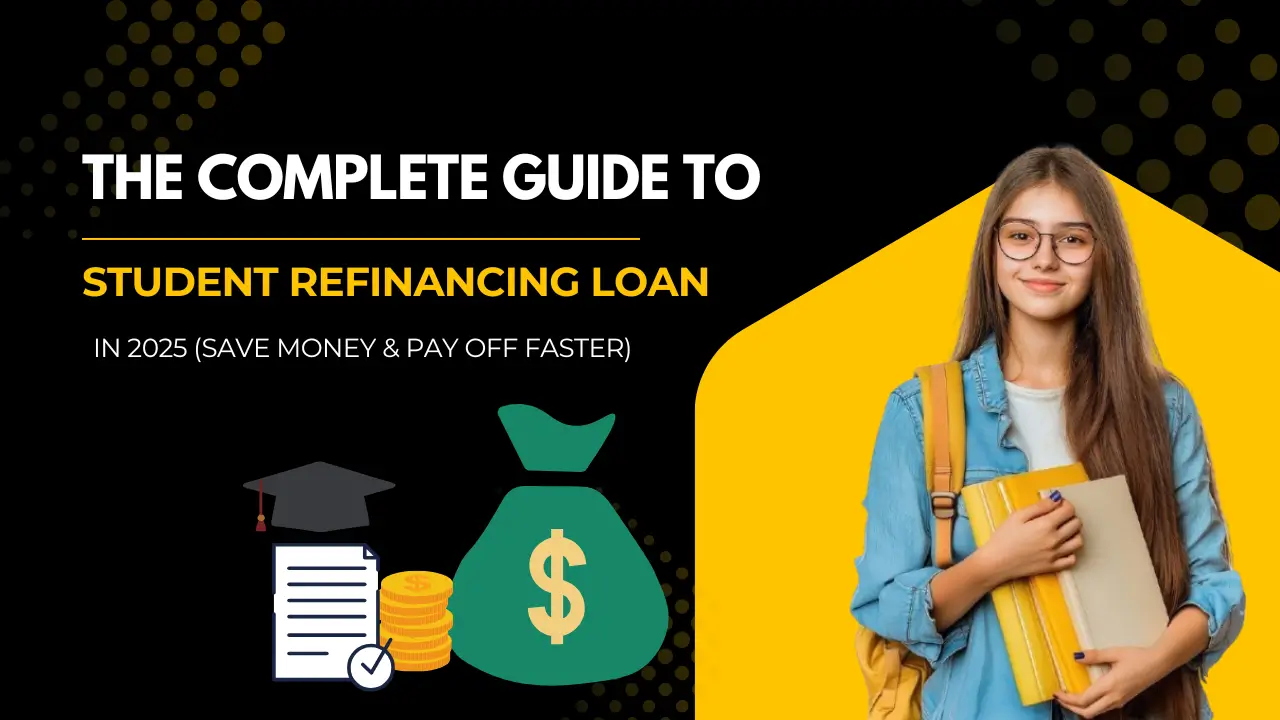Higher education costs keep going up, leaving many with big debts. Refinancing is a way to handle this financial load.
This guide will show the good sides of refinancing student loans. We’ll walk you through the steps to do it right. By the end, you’ll know how to cut costs and clear your debt quicker.
Key Takeaways
- Understand the benefits of refinancing your student loans
- Learn how to qualify for the best refinance rates
- Discover the top lenders for student loan refinancing
- Get tips on how to pay off your debt faster
- Explore the potential savings of refinancing
What Is Student Loan Refinancing?
Refinancing student loans means swapping one or more loans for a new one with a lower interest rate or better terms. This can help borrowers manage their loans better and save money in the long run.
The Basics of Refinancing Student Loans
When you refinance student loans, you pay off old loans with a new one from a private lender. The new loan covers the old ones, and you start making payments on it. Important things to think about include:
- The interest rate of the new loan
- The repayment term, which can be shorter or longer than the original loans
- Any fees associated with the new loan
Federal vs. Private Student Loan Refinancing
It’s important to know the differences between refinancing federal and private student loans. Refinancing federal loans might mean losing benefits like income-driven repayment plans and loan forgiveness programs. But refinancing private loans usually doesn’t have these risks. Borrowers should think carefully about these points when deciding to refinance.
When choosing between federal and private refinancing, consider these:
- Assessing the potential loss of federal benefits
- Comparing interest rates and repayment terms
- Evaluating the borrower’s financial situation and goals
Benefits of Student Loan Refinancing in 2025
Refinancing student loans in 2025 offers many benefits. These include lower interest rates and easier loan management. Knowing these perks can help borrowers make smart choices about their loans.
Lower Interest Rates
One key advantage is getting lower interest rates. In 2025, rates might change. Refinancing can help you get better rates if your credit score improves or if rates drop. This can save a lot of money over time.
https://www.youtube.com/watch?v=4iGo7nPreGs
Reduced Monthly Payments
Refinancing can also mean reduced monthly payments. This makes it easier to handle your finances. By getting a longer loan term or a lower rate, you can pay less each month. This gives you more money for other needs or savings.
Simplified Loan Management
Another plus is simplified loan management. Combining multiple loans into one makes paying back easier. It simplifies due dates and payments. This keeps you organized and avoids missed payments.
Potential for Faster Payoff
Lastly, refinancing can lead to a faster payoff. A lower interest rate or better terms means you can pay off your loan quicker. This saves on interest and gets you financially free sooner.
Is Student Loan Refinancing Right for You?
Before you decide on student loan refinancing, check your finances and goals. It can lower your interest rates and monthly payments. But, it’s not for everyone.
When Refinancing Makes Sense
Refinancing is good if you get a lower interest rate than your current loan. This can save you a lot of money over time. It also helps if you have loans with different rates and due dates. It simplifies your payments into one manageable loan.
When to Avoid Refinancing
Refinancing might not be the best choice in some cases. For example, if you have federal loans, refinancing with a private lender can mean losing benefits. These include income-driven repayment plans and Public Service Loan Forgiveness. Also, avoid it if you’re unsure about making the new payments.
Impact on Different Types of Borrowers
The effect of refinancing differs for various borrowers.
Recent Graduates
Recent graduates can benefit from refinancing if they have a steady job and good credit. It helps them get a lower interest rate before rates go up.
Mid-Career Professionals
Mid-career professionals can get better loan terms if their credit score has improved since taking out their loans. This can lead to more favorable loan conditions.
Parents with PLUS Loans
Parents with PLUS loans might find refinancing helpful in lowering their monthly payments. This is true if they can get a lower interest rate.
| Borrower Type | Refinancing Benefits | Considerations |
|---|---|---|
| Recent Graduates | Lower interest rates, simplified payments | Stable income, good credit score |
| Mid-Career Professionals | Better loan terms with improved credit | Credit score improvement since original loan |
| Parents with PLUS Loans | Reduced monthly payments | Potential loss of federal benefits |
How to Qualify for Student Loan Refinancing
Lenders look at several key factors to decide if you can refinance your student loans. Knowing what they look for can help you get ready and boost your chances.
Credit Score Requirements in 2025
A good credit score is key for refinancing student loans. Most lenders want a score of 650-700. But, some might be stricter or more lenient.
Key credit score considerations:
- A score above 700 can get you better interest rates.
- A score below 650 might need a co-signer or higher rates.
- Checking your credit report for errors can boost your score.
Income and Employment Criteria
Lenders also check your income and job to make sure you can pay back the loan. They usually look for:
- A steady income.
- A low debt-to-income ratio.
- A job with a reputable company.
Self-employed people might need to show more, like tax returns.
Debt-to-Income Ratio Considerations
Your debt-to-income (DTI) ratio is very important. Lenders like a DTI under 36%. A lower DTI shows you can handle your debt better.
Co-Signer Options and Requirements
If your credit is limited or not great, a co-signer can help. The co-signer needs a good credit score and steady income.
Co-signer considerations:
- Make sure your co-signer knows their duties.
- Pick a co-signer with a solid credit history.
- Some lenders let you release the co-signer after a while.
By knowing and meeting these criteria, you can refinance your student loans. This might save you money on interest.
Step-by-Step Guide to Student Loan Refinancing
Refinancing student loans can seem tough, but it’s easier when broken down. Knowing the steps helps borrowers feel confident and could save them money.
Gathering Your Loan Information
The first step is to collect all your loan details. You’ll need to know the balances, interest rates, and repayment terms of your loans. Having this info ready makes the application smoother.
Researching Lenders and Rates
Next, look into different lenders and their rates. It’s important to compare rates to find the best one. Look at the lender’s reputation, customer service, and any extra benefits they offer.
Prequalification Process
Many lenders let you prequalify without hurting your credit score. This helps you see potential rates and terms. It narrows down your choices to lenders that might offer you a good deal.
Submitting Your Application
After picking a lender, you’ll apply formally. You’ll need to share financial details like income and job status. Be ready to provide documents to back up your application.
After Approval: Loan Disbursement and Repayment
After approval, the lender pays off your old loans. Then, you start repaying the new loan. Knowing your repayment plan and how to make extra payments can help manage your debt.
By following these steps, borrowers can refinance their loans successfully. This could lower their interest rates and make their financial life easier.
Top Student Loan Refinancing Lenders in 2025
Borrowers are looking for the best student loan refinancing lenders in 2025. With more people refinancing, lenders are trying to offer the best deals. We’ll look at the top lenders in different categories.
Best Overall Refinancing Options
The best refinancing options have low interest rates, flexible terms, and great customer service. SoFi and CommonBond are often chosen for their wide range of benefits.
| Lender | Interest Rate Range | Repayment Terms |
|---|---|---|
| SoFi | 3.99% – 13.95% | 5 – 20 years |
| CommonBond | 4.24% – 14.39% | 5 – 15 years |
Best for Low Interest Rates
For the lowest rates, ELFI and PennyMac are great choices. They offer flexible repayment plans for different budgets.
| Lender | Interest Rate Range | Repayment Terms |
|---|---|---|
| ELFI | 2.90% – 8.00% | 5 – 20 years |
| PennyMac | 3.25% – 8.00% | 5 – 15 years |
Best for Borrowers with Average Credit
Borrowers with average credit can find good options with LightStream and College Ave. They consider more credit profiles and offer custom loans.
| Lender | Credit Score Requirement | Repayment Terms |
|---|---|---|
| LightStream | 650+ | 5 – 15 years |
| College Ave | 600+ | 5 – 15 years |
Best for Additional Benefits and Perks
Laurel Road and Earnest are known for extra perks. They offer career advice, flexible payments, and no fees.

| Lender | Notable Benefits |
|---|---|
| Laurel Road | Career counseling, no fees |
| Earnest | Flexible payment options, no fees |
By looking at these top lenders, borrowers can make smart choices for 2025.
Common Student Loan Refinancing Mistakes to Avoid
Refinancing student loans can be smart, but there are pitfalls to watch out for. As the student loan world changes in 2025, knowing these mistakes is key to making good choices.
Refinancing Federal Loans Without Consideration
Many borrowers refinance their federal loans without thinking it through. Federal loans offer benefits like income-driven plans and forgiveness programs. Switching to private loans can mean losing these perks. It’s important to think carefully before making a choice.
Not Shopping Around for the Best Rates
Not comparing rates is a big mistake. Even a tiny rate difference can save a lot over time. Borrowers should look at rates from several lenders. Comparing rates from at least three different lenders can lead to a better deal.
Ignoring the Fine Print and Terms
Ignoring the loan’s details is a major error. Borrowers must read the agreement to know the interest rate, repayment terms, and fees. Hidden fees or variable interest rates can greatly increase the loan’s cost.
Missing Out on Potential Discounts and Benefits
Lenders often offer discounts for things like autopay or on-time payments. Borrowers should ask about any discounts they might get. For example, some lenders give a 0.25% interest rate reduction for autopay.
Overlooking Digital Tools and Resources
Many borrowers don’t use the digital tools and resources available. Lenders often have online portals or apps for managing loans. Using these tools can help borrowers keep track of payments and make better loan decisions.
By avoiding these common mistakes, borrowers can better navigate refinancing and save money in the long run.
Alternatives to Student Loan Refinancing
Beyond refinancing, borrowers can explore other ways to simplify their student loan payments. These options can help reduce financial stress. While refinancing works for some, others might find better solutions for their financial needs.
Income-Driven Repayment Plans
Income-driven repayment plans are a great alternative, helping those who struggle with monthly payments. These plans adjust payments based on income and family size. This can make payments more affordable.
Loan Forgiveness Programs in 2025
Loan forgiveness programs offer another option, potentially wiping out part or all of a borrower’s debt. Programs like Public Service Loan Forgiveness (PSLF) forgive loans for those working in qualifying public service jobs after a set number of payments.
Loan Consolidation vs. Refinancing
It’s key to know the difference between loan consolidation and refinancing. Consolidation combines multiple loans into one, making payments simpler. Refinancing replaces existing loans with a new one, often at a lower interest rate. Consolidation is a federal option that keeps certain benefits, while refinancing is offered by private lenders.
Employer Student Loan Assistance Programs
Some employers help with student loan payments as a benefit. This can be a big alternative to refinancing. It directly reduces debt without needing a new loan.
- Explore income-driven repayment plans to adjust monthly payments based on income.
- Look into loan forgiveness programs, such as PSLF, for potential debt cancellation.
- Understand the difference between loan consolidation and refinancing to choose the best option.
- Check if your employer offers student loan assistance programs.
Conclusion: Maximizing Your Student Loan Refinancing Strategy
The world of student loan refinancing is changing in 2025. Borrowers need to stay up-to-date to get the most from their options. Understanding the benefits, what you need to qualify, and the possible downsides is key.
Refinancing can help lower your interest rates and monthly payments. It also makes managing your loans easier. To succeed, you must assess your finances, credit score, and loan terms carefully.
Looking into rates from top lenders like SoFi, Earnest, and Lending Club is crucial. You should also know the risks, like losing federal loan perks when refinancing federal loans.
A smart refinancing plan can save you a lot and help you pay off your loans faster. By following this guide, you can make wise choices and manage your debt better.
FAQ
What is student loan refinancing?
Student loan refinancing means swapping an old loan for a new one. The new loan often has a lower interest rate and smaller monthly payments.
How does student loan refinancing work?
It starts with applying for a new loan from a private lender. This lender pays off your old loan. The new loan comes with its own terms, like interest rate and repayment period.
What are the benefits of refinancing student loans in 2025?
Refinancing in 2025 can lead to lower interest rates and smaller monthly payments. It also simplifies loan management and can help you pay off your loan faster.
Can I refinance federal student loans?
Yes, you can refinance federal loans with a private lender. But, be aware that you might lose federal benefits like income-driven repayment plans and loan forgiveness programs.
What credit score is required for student loan refinancing?
The credit score needed varies by lender. Generally, a score of 700 or higher is considered good.
Can I refinance student loans with a co-signer?
Yes, many lenders allow co-signers for refinancing. A co-signer with good credit can help you get a lower interest rate.
How do I choose the best lender for student loan refinancing?
Look at interest rates, repayment terms, and fees. Choose lenders with flexible options, good customer service, and online tools.
What are the alternatives to student loan refinancing?
Alternatives include income-driven repayment plans, loan forgiveness, consolidation, and employer assistance programs.
Will refinancing student loans affect my credit score?
Yes, refinancing can impact your credit score. Lenders usually do a hard credit check during the application process.
Can I refinance multiple student loans at once?
Yes, many lenders let you consolidate multiple loans into one. This can result in a lower interest rate and a single monthly payment.







